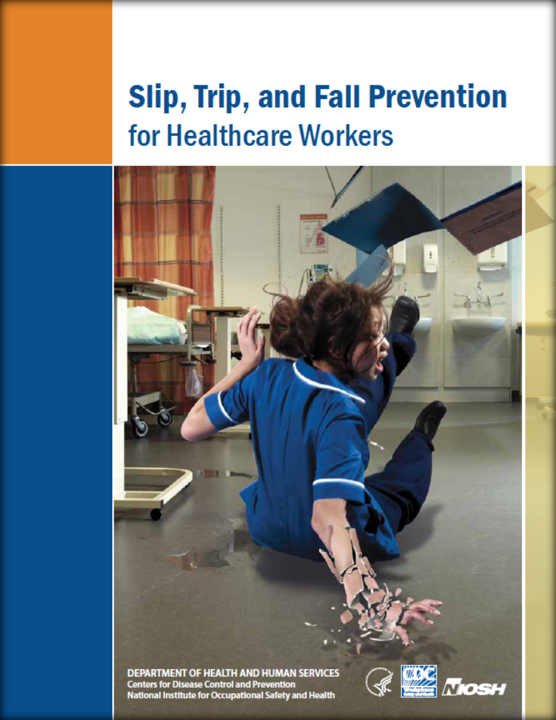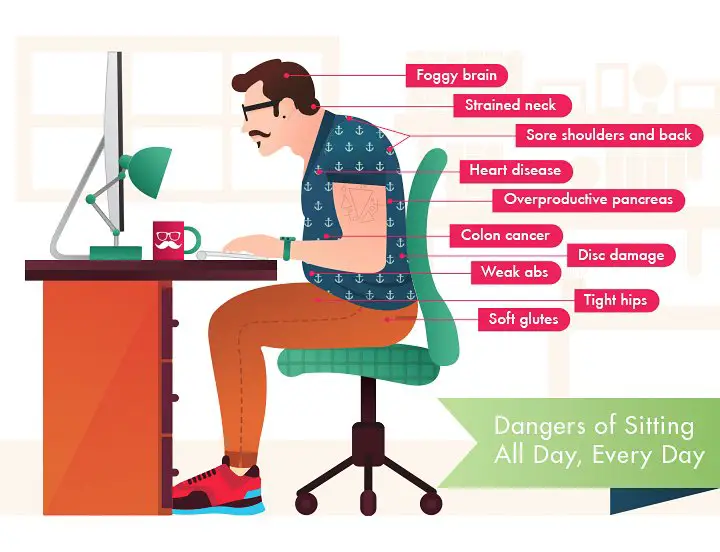Slip, Trip, and Fall Prevention for Healthcare Workers book emerged from a multi-institutional, multi-disciplinary research partnership including NIOSH, BJC Health System, the Finnish Institute for Occupational Health, Liberty Mutual Research Institute for Safety, the Johns Hopkins School of Public Health, the Veteran’s Health Administration, and Washington University School of Medicine.
This workbook identifies the top 10 STF hazards specific to healthcare facilities. For each hazard this workbook will:
- Explain how the hazard contributes to STFs,
- Identify where the hazard is likely to occur, and
- Provide recommendations to reduce or eliminate the hazard.
Slips, trips, and falls are preventable. This workbook provides guidance on implementing a STF prevention program to protect healthcare workers. The goal of the workbook is to familiarize you with common STF hazards in healthcare facilities so you are able to recognize and reduce the risk to employees. Throughout the workbook, pictures show either prevention strategies or hazards in healthcare facilities. Pictures outlined in red are hazards.

In addition, both visitors and patients will benefit from an STF prevention program in your facility reducing their risk as well. To further assist you, a checklist is provided on page 35 to help you identify different hazards in your healthcare facility. ( Photo of the day: 5 ways to reduce the risk of Slipping and Tripping )
Who Should Use the Workbook?
The Workbook is intended for healthcare facility administrators, safety and health professionals, facility managers, housekeeping managers, food service managers, and workers who are responsible for safety.

Top 10 Hazards
1- Contaminants on the Floor (Water, Grease, Oil, Fluid, Food)
What is the hazard?
Contaminants on the floor are the leading cause of STF incidents in healthcare facilities [Courtney et al. 2006, Bell et al. 2008]. Water, grease, and other fluids can make walking surfaces slippery. Well-documented housekeeping procedures, correct floor cleaning, proper usage of mats and signs, accessible clean-up materials, and slip-resistant shoes will help to minimize the risk of slipping (ANSI 2001). ( Slips,Trips and Falls checklist )
Where does the hazard occur?
- Food services areas: kitchen, cafeteria, serving line, buffet, ice machines, freezers, dishwashers, sinks, and drains (please refer to the drainage section for additional information on page 14) (see Figures 1.1 and 2.3)
- Decontamination area: when wet equipment is transferred from one area to another
- Soap dispensers
- Drinking fountains
- Building entrances, where rain and snow are tracked inside
Prevention Strategies
Provide and maintain a written housekeeping program.
A written housekeeping program can help ensure the quality and consistency of housekeeping procedures. A copy of the housekeeping program should be provided to all employees and they should know where to find additional copies. The program should describe
- How to immediately contact the housekeeping department
- Where and how cleaning materials and products are stored
- When to use wet floor signs and barriers and where signs are stored
- When specific areas of the healthcare facility should be cleaned
- What cleaning methods are appropriate for different areas and surfaces
Ways that Mats Create Safe, Slip-Free Work Environments
Keep floors clean and dry.
- Encourage workers to cover, clean, or report spills promptly.
- Hang or place spill pads (see Figures 1.3a, 1.3b, 1.3c), paper towel holders, pop-up-tent wet floor signs (see Figures 1.4a, 1.4b) in convenient locations throughout the healthcare facility so employees have easy access to products to clean, cover, and highlight a spill.
- Advertise phone/pager numbers for housekeeping through emails, posters, and general awareness campaigns.
- Place water-absorbent walk-off mats where water, ice, or soap may drip onto the floor (see Figure 1.5). Use beveled-edge, flat, and continuous mats. (For more information on mats, please refer to the section on Improper Use of Floor Mats).
- Provide walk-off mats, paper towel holders, trash cans, and umbrella bags near entrances and water fountains to minimize wet floors (see Figure 1.6, page 12).
- Mats should be large enough so that several footsteps will take place on the mat; if there is water around or beyond the mat, it means that the mat is not large enough and/or is saturated and needs to be replaced.
- Secure mats from moving and make sure they have slip-resistant backing. Remind staff to lay mats in the correct position daily, and use visual cues such as tape on the floor if necessary.
- Make sure that drip pans of ice machines and food carts are properly maintained so that water does not spill onto the floor.
(Read E-Books: Fall Prevention and Protection Principles Guidelines and practices )
Contents
The content of Health and Safety at Work Key Terms
- Part I. Introduction . . . . . . . . . . . . . . . . . . . . . . . . . . . . . . . . . . . . . . 1
- Slip, Trip, and Fall (STF) Prevention for Healthcare Workers 3
- Part II. Top 10 Hazards . . . . . . . . . . . . . . . . . . . . . . . . . . . . . . . . . . . 7
- Contaminants on the Floor . . . . . . . . . . . . . . . . . . . . . . . . . . . 9
- Poor Drainage: Pipes and Drains . . . . . . . . . . . . . . . . . . . . . . 14
- Indoor Walking Surface Irregularities . . . . . . . . . . . . . . . . . . 16
- Outdoor Walking Surface Irregularities . . . . . . . . . . . . . . . . . 17
- Weather Conditions: Ice and Snow . . . . . . . . . . . . . . . . . . . . . 19
- Inadequate Lighting . . . . . . . . . . . . . . . . . . . . . . . . . . . . . . . . . 20
- Stairs and Handrails . . . . . . . . . . . . . . . . . . . . . . . . . . . . . . . . . 21
- Stepstools and Ladders . . . . . . . . . . . . . . . . . . . . . . . . . . . . . . . 23
- Tripping Hazards: Clutter, Loose Cords, Hoses, Wires,
and Medical Tubing . . . . . . . . . . . . . . . . . . . . . . . . . . . . . . . 24 - Improper Use of Floor Mats and Runners . . . . . . . . . . . . . . 27
- Part III. Tools for STF Prevention . . . . . . . . . . . . . . . . . . . . . . . . . . 29
- Examine Employee Slips, Trips, and Falls Injuries:
- The First Steps Toward Prevention . . . . . . . . . . . . . . . . . . . . 31
- Employee Communication: Training and Involvement . . . . . . 34
- Slips, Trips, and Falls Checklist . . . . . . . . . . . . . . . . . . . . . . . . . . 35
- Literature Cited . . . . . . . . . . . . . . . . . . . . . . . . . . . . . . . . . . . . . . . 40
Download the book
E-Books: Slip, Trip, and Fall Prevention for Healthcare Workers
More Downloads
- E-Books: Healthcare Hazard Control & Safety Management
- E-Books: Safety, Health and Working Conditions Training Manual
- E-Books: Energy Efficiency in Water and Wastewater Facilities
- E-Books: Fire Service Features of Buildings and Fire Protection Systems
- E-Books: Evaluation of Fire Safety free download
- E-Books: PPE for Chemical, Biological, and Radiological Hazards free
- E-Books: Changing the Workplace Safety Culture free download
- E-Books: Site Emergency Planning Workbook
- E-Books: Load Restraint Guide
- E-Books: Essential Practices for Creating, Strengthening, and Sustaining Process Safety Culture
- E-Books: System Safety Engineering and Risk Assessment
- E-Books: Permit-Required Confined Spaces
- E-Books: Is it Safe to Enter Confined Space?
- E-Books: 5-Minute Workplace Safety Talks
- E-Books: Safety Culture and High-Risk Environments
- E-Books: Practical Guide to Industrial Safety
- E-Books: Slip, Trip, and Fall Prevention for Healthcare Workers
- E-Books: Health and Safety at Work Key Terms
- E-Books: Fundamentals of Process Safety Engineering
- E-Books: Gas Detection Hand Book
- E-Books: Occupational health and safety management systems ANSI-AIHA-z10-2012
- E-Books: Hot Work on Drums and Tanks
- E-Books: Human Fatigue Risk Management
- E-Books: Guidelines for the provision of facilities and general safety in the construction industry
- E-Books: Handbook of Training in Mine Rescue and Recovery Operations ( 2021)
- E-Books: Code of Practice for the Safe Use of Lifting Equipment – Edition 9 (Nov 2019)
- E-Books: Free Forklift Health and Safety Best Practices Guideline
- E-Books: Handbook of Hazardous Chemical Properties
- E-Books: Human Performance Improvement through Human Error Prevention
- E-Books: Principles Of Fire Risk Assessment In Buildings
- E-Books: Investigation of Occupational Accidents and Diseases
- E-Books: Radiation Protection and Safety in Industrial Radiography
- E-Books: Basic Guide to System Safety, Third Edition
- E-Books: Food Safety Management-A Practical Guide for the Food Industry
- E-Books: Safety identification: Escape and evacuation plan signs- ISO 23601
- E-Books: Safety at Work
- E-Books: The Safety-Critical Systems Handbook 4th edition
- E-Books: Fundamental principles of occupational health and safety
- E-Books: Fire Safety Risk assessment Guide – Sleeping Accommodation
- E-Books: Mental health at work series
- E-Books: Live Fire Training: Principles and Practice
- E-Books: Pre-Startup Safety Review Guide
- E-Books: Fire and Emergency Drill Manual and Building Inspection Guide
- E-Books: Health and Safety: Risk Management 5th edition
- E-Books: Fire Protection systems -Third edition 2021
- E-Books: Fire Safety Logbook templates
- E-Books: From Accidents to Zero
- E-Books: Electric Safety Practice and Standards
- Your steps to chemical safety
- E-Books: Ergonomics and Psychology Developments in Theory and Practice
- E-Books: HAZOPS Should BE fun-The Stream-Based HAZOP
- E-Books: Safety Health and Environmental Auditing
- E-Books: A Quick Guide to Health and Safety
- E-Books: Occupational Ergonomics A Practical Approach
- E-Books: Job Hazard Analysis A Guide for Voluntary Compliance and Beyond
- E-Books: Electrical Safety of Low Voltage Systems




